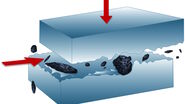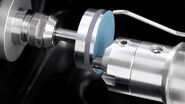Battery particle detection during production
Lithium-ion (Li-ion) battery production consists of several steps: electrode manufacturing, cell assembly, cell finishing, and battery activation (refer to figure 1). Particle contamination mainly comes from the electrode production process due to cutting and punching of materials. During each of the battery production steps, particle contamination needs to be kept under control which necessitates using detection, identification, and analysis methods. For this reason, typically cleanliness analysis is done as part of quality control (QC) and failure analysis (FA). Particle traps are used to collect particles generated during specific production steps along the production line and help monitor the overall amount of particulate contamination.
The presence of different types of particles with sizes from micrometers to millimeters in Li-ion batteries can negatively impact their performance, lifetime, reliability, and safety (refer to figure 2) via short circuits, overheating, and thermal runaway [1].
Currently, the main challenge for efficient particle detection and analysis during battery production is identifying and counting particles acquired with traps or stamps in a practical, efficient way. The analysis should be performed in, at, or at least very nearby the production line. Occasionally as a separate QC validation step, particles are detected directly on the electrode material to verify counter measurements and to check the overall particle load, but this measurement is destructive for electrodes.
Why is particle detection important for batteries?
Eliminating or minimizing particles during production results in better performance and reliability of Li-ion batteries. Particles can damage the battery cell structure, electrodes, and separators which may lead to short circuits (metallic and conductive particles), overheating, and thermal runaway [1]. At times, these battery problems or failures are found even when only small particles are present on the electrode materials due to lithium dendrite growth or mechanical stress caused by fast charging [2-4].
Therefore, particle and defect detection is critical during the fabrication and assembly of batteries. Efficient detection and analysis are important for identifying harmful particles and defects, ensuring reliable quality control during production [4-6]. As the demand for batteries grows, leading to ever-increasing mass production, the need for efficient, reliable detection of particle contamination, which can eliminate or at least minimize it, is becoming more urgent.
Methods for particle detection and analysis
Several methods can be applied to perform particle detection and analysis, e.g., optical and electron microscopy and spectroscopy. In particular, optical microscopy is a fast and versatile technique which offers many advantages for particle detection. It provides both qualitative and quantitative information of particles. Through the use of a variety of illumination and contrast methods, particles can be quickly identified, counted, measured, and classified according to their size and reflectivity (generally metallic vs. non-metallic) to help determine their damage potential [6,7]. However, particle composition can only be determined using advanced techniques like laser spectroscopy [5-7].
For visual and compositional characterization of particles during battery production, scanning electron microscopy (SEM) and energy-dispersive x-ray spectroscopy (EDS) are often exploited during battery production [5,6]. While SEM and EDS offer higher resolution with accurate measurement of the particle lateral size and chemical analysis with quantitative compositional information, the methods are expensive and time-consuming.
There is a powerful alternative technique: a 2-methods-in-1 solution combining optical microscopy and laser-induced breakdown spectroscopy (LIBS). This solution can be much more easily utilized for particle detection and analysis at the battery production line, thus making rapid, reliable, and cost-effective QC possible.
With optical microscopy alone, visual analysis can rapidly provide data on the width, length, height (XYZ), and reflectivity of particles (refer to figure 3) [5,6]. However, when combining it with LIBS, chemical analysis allows qualitative compositional data of particles to be quickly obtained [5,6]. To better understand a particle’s potential to cause damage (often called the particle damage potential) to the battery system, knowing both a particle’s size and composition is important. The size and composition data can help tremendously when determining a particle’s properties, i.e., dimensions, conductivity, hardness, and chemical reactivity, as well as the source of contamination.
Maximize battery performance and minimize risk of failure with Leica solutions
To achieve rapid, reliable, and cost-effective battery particle detection and analysis without using an electron microscope, users can take advantage of Leica cleanliness analysis solutions [5,6].
If the need is to count particles, measure their XYZ dimensions, and classify them according to reflectivity rapidly and reliably, then a Leica compound microscope equipped with a digital camera and the cleanliness analysis software works well.
However, if users require the same characterization mentioned just above, but in addition need to determine particle composition efficiently, then the Leica 2-methods-in-1 solution with LIBS and the cleanliness analysis software is the more appropriate solution (refer to figure 4).
Summary and conclusions
Particle contamination during production poses several challenges for battery manufacturers. Particles of different sizes and compositions can deposit inside battery cells and contribute to short circuits, overheating, poor performance, and short battery life. Fast and accurate identification of potentially damaging particles is necessary for a rapid and reliable QC during battery production. Cleanliness analysis solutions exploiting optical microscopy can be used for efficient and cost-effective battery particle detection and analysis. To have a better understanding of a particle's potential to cause damage, it is an advantage to use a 2-methods-in-1 solution, combining optical microscopy with LIBS, for simultaneous visual and chemical evaluation of particles.









